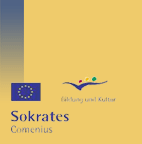|
Preparation:
A ready-made pinhole camera as a visual aid.
Material for the children:
Empty cardboard boxes, cardboard tubes, tracing paper, scissors, pens,
Scotch tape, magnifying glasses.

|
Steps:
The children examine the
ready-made pinhole camera made of cardboard (Effect: Picture is upside down)
Making a camera / Steps:
1. Use the
cardboard tube to draw a circle on the back of the box.
2.
Cut the circle out carefully.
3. Push the
cardboard tube into the hole. You must be able to move it.
4. Glue the magnifying
glass firmly to the end of the cardboard tube.
5.
Glue tracing paper before the opening of the box.
6. Hold the camera
in front of a bright object. An image of the item appears on the tracing
paper.
After this the children
experiment with the cameras they have made by searching for subjects that they want to look at and
examine.
|
|
Scientific Explanation:
The magnifying glass serves as a lens. It breaks the incoming light
beams and throws the picture on the tracing paper. The picture is the wrong way
around and upside down because the glass bundles the light beams and passes
them on the other way round.
In a real camera a lens is used instead of the magnifying glass and a
film instead of the tracing paper.
When the roll is moved back and forth the picture becomes sharp or
blurred, similar to the zoom of a real camera.
Bright or dark subjects influence the precision of the reproduction.
|
Possible Variation:
Older children may at first examine a simple, older camera and
experiment with the materials provided as long as they need to find the right
solution. During this phase they will realize how a camera works by talking
to each another. The nursery school teacher may help.
|











